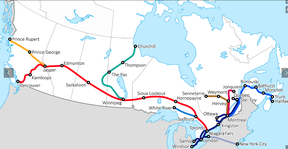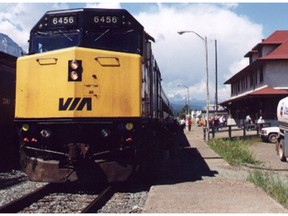Douglas Todd: They’re fun. They’re ecological. They’re so Canadian. But Ottawa no longer really cares about passenger trains to most towns and cities — especially in the Western provinces.
Article content
Passenger trains. Freight trains. I’ve got to admit I like them.
They seem so Canadian. At least they used to. Trains no longer bring together people across this vast land like they did.
As kids, in addition to travelling through B.C. and Alberta by train, we would sometimes put coins on tracks and, after the lumbering beasts rolled over them, marvel how the flattened metal turned into something completely different. I only learned later our game was illegal. Sorry about that.
Advertisement 2
Article content
I also worked as a porter in the 1970s, with white jacket and black cap, on the Canadian Pacific Rail passenger run between Vancouver, Calgary and Winnipeg. It was almost romantic, even with 20-hour shifts. It was fascinating to meet the rural folk who relied on the train.
But times have changed, and not for the better.
Government negligence is making Canadian train service much worse than it was in the 1970s, especially in the Western provinces.
And the current labour dispute — which sees Canadian National Railway Co. and Canadian Pacific Kansas City resuming service this week after both companies locked out their workers last Thursday — is bringing some indirect attention to the devolution.
Unlike in the past, few Canadians, particularly from towns and smaller cities, can rely on trains to get from A to B.
The same, unhappily, is the case with bus service. The shutting down of Greyhound in Western Canada in 2018, and transnationally in 2021, has been devastating to rural areas.
And that’s not to mention that airlines are continuing to cut back on their short-haul regional routes in Canada.
Article content
Advertisement 3
Article content
All these transportation losses are occurring despite obvious evidence trains and buses are by far the more ecological means of transportation. Despite many Canadian politicians going out of their way to claim they consider climate change Priority 1, they somehow remain dumb, in more ways than one, about combating carbon emissions with better large-scale ground transportation.
Unfortunately, the one thing about Canadian trains that hasn’t changed is a negative.
The same passenger railcars that I worked on, which were built in the 1950s, are the same carriages that Via Rail, the Crown corporation that took over the passenger system in 1978, is using today.
It’s ridiculous — and not only in regard to maintenance and safety. The antique train equipment, which critics say might be the oldest in use in the world, poses one of several looming crises for what’s left of Canada’s passenger rail system.
To put it bluntly, B.C., Alberta, Saskatchewan and Manitoba are getting shafted. Because of shoddy or non-existent rail service, less than four per cent of Via Rail’s customers are now in the Western provinces.
Advertisement 4
Article content
And even though the federal government has promised to build new train cars and puts moderate energy into Via Rail in Eastern Canada, its big promise to start a more efficient private service, called high-frequency rail (HRT), will connect only the major cities of the Quebec City-Windsor corridor.
Meanwhile, in Western Canada, if you’re in a town or on a First Nations reserve and can’t afford a plane flight, there are precious few ways to get from place to place.

You could try your luck with the once-in-a-while, not particularly cheap trips offered by some small private bus companies, some of which B.C. Transit modestly subsidizes. No wonder rural people resent the politicians who focus on city slickers.
It adds up to a fiasco. Canada isn’t only lagging behind the U.S., we shouldn’t even be mentioned in the same breath as nations that truly prioritize trains. They include almost all of Europe, especially Austria, France, the Czech Republic, Germany, Italy, Romania and Britain. Japan is legendary for its shiny, ultrafast trains. The systems of India and China are also extensive.
Advertisement 5
Article content
The B.C. NDP MP for Skeena-Bulkley-Valley, Taylor Bachrach, last Christmas found a clever way to draw attention to some of Canada’s rail problems.
Bachrach rode the only remaining cross-Canada passenger line — which Via Rail runs from Toronto through Edmonton to his hometown of Smithers. (The old line I worked on, through Calgary, stopped service in the 1990s.) Bachrach’s trip was expensive and, as he says, mostly designed for tourists.
And what’s more — it took 5½ days of travel time.
Which was slower than it would have taken, um, seven decades ago.

The train scheduling issue Bachrach was trying to raise signals how Ottawa isn’t even keeping up with the U.S.
The NDP’s transportation critic, who become fond of trains while growing up in a remote B.C. town, used the journey to publicize his private member’s bill, C-371, which aims to convince Ottawa to follow the U.S., where federal law requires passenger trains on the government-subsidized Amtrak system be given preference over freight trains.
That’s not the case in Canada. In this country, passenger trains must always defer to freight trains, of which there are many more. It makes scheduling, to say the least, slow and unpredictable. If not a joke.
Advertisement 6
Article content
In the midst of the chronic unreliability, Bachrach this year also sponsored an electronic petition that has proved popular. E-4754 eloquently urges the Liberals to take action to fix passenger rail service in Canada.
As a kid in tiny Dunster, west of Jasper, Alta., Bachrach literally grew up next to the tracks. He fondly recalls the workers on speeders who would toss their lunch juice boxes to him. It made him feel connected to the rest of Canada. Today he can’t stand seeing “a massive swath of rural Canada left out” of train travel.
Similarly, one of my train memories is of hitchhiking across the country as a teenager — and thinking in Thunder Bay, Ont., it was time to hop aboard a freight train, as if I could live out Woody Guthrie’s song, Hobo’s Lullaby. In the end, thinking of safety and legality, I didn’t. But it seemed like an incredible possibility at the time.
Whatever memories one holds, Bachrach is on to something when he says the dream of a real network of trains captures the imaginations of Canadians. With a little ambition, he rightly says, the federal government could again use trains to bolster the nation’s fabric.
Advertisement 7
Article content
In a time that feels increasingly divided, it would be a wonderful way to again weave people together across this great land.
Recommended from Editorial
Bookmark our website and support our journalism: Don’t miss the news you need to know — add VancouverSun.com and TheProvince.com to your bookmarks and sign up for our newsletters here.
You can also support our journalism by becoming a digital subscriber: For just $14 a month, you can get unlimited access to The Vancouver Sun, The Province, National Post and 13 other Canadian news sites. Support us by subscribing today: The Vancouver Sun | The Province.
Article content



